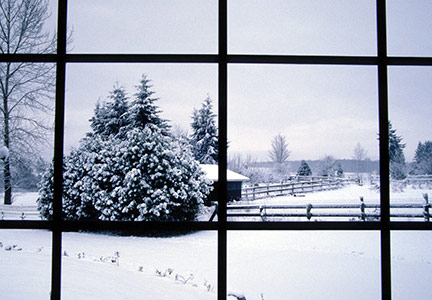It’s pretty easy getting yourself ready for winter. Stuff those shorts in the back of the drawer and pull the sweaters and jackets out of storage. However, getting your house ready for the colder months is another story. Whether you’re a snowbird planning on flying south for the winter or you’re planning on slugging it out in the colder climes, there’s work to be done to make sure that your home, and more importantly, those inside it, makes it through winter unscathed. So, until someone invents a turtleneck sweater you can put around your house when it gets cold, there’s some organizing to do.

Alicia on “The Benefits”
“When you look at winterizing your home purely on an organizational level it can seem like a real pain in the neck. But if you look at it from a financial side, things start looking a little more do-able. Winter heating costs can skyrocket if your windows are poorly insulated, your plumbing breaks, or if your heating system is out of date or broken. Keeping on top of your home’s winter preparedness can save you a nice chunk of money in the winter months, while also protecting your property for the long term.”
Sarah on “Break It Down”
“Winterizing your house can seem kind of overwhelming when you look at it as one giant to-do. Try breaking it down into two or three tasks that you take care of over the next three to four weekends. Take on the windows one weekend, checking every window in the house for drafts and insulation needs, then look at the pipes another weekend. Make things even easier by breaking up the task between members of the family, assigning each person their own room to inspect and report back on whether it’s ready for winter.”
Get organized to get winterized with the tips below.
#1: Winterize the Plumbing
Drain water from outdoor faucets and garden hoses and arrange to have any in-ground sprinkler pipes blown out. Roll up the garden hoses and store them inside. Identify any “problem” pipes that are prone to freezing in the house and consider using heat tape to keep them warm during extremely cold weather. Along those same lines, make sure your entire family knows how to turn water off at the source in case a pipe leaks in the winter. That way, if, heaven forbid, you do have a pipe burst, everyone knows how to stop a leak as soon as it starts.
#2: Prepare Sources of Heat
Who doesn’t enjoy long, cozy afternoons by a crackling fire? Ensure your fireplace is ready to be used this winter. Have the chimney inspected and cleaned by a professional now. In addition, have a professional do a routine check of your heating systems before cold weather arrives to vacuum your vents and other heating components. If your furnace has a filter, check to see if it needs to be replaced. As a potential energy saving measure, consider installing a setback thermostat that keeps the home cooler when you are asleep or away.
#3: Seal the Leaks
Keep the draughts to a minimum this winter. If you have them, install storm windows and doors – and don’t overlook the basement! Add or replace worn weather stripping around the doors and windows too and caulk any gaps. If door stops are worn, replace them. If you have pipes or ducts that travel through an exterior wall, be sure to use caulking and weather-stripping around all entry points. Bottom line: block any potential entry point for cold air!
[Editor's note: If you seal up your home tight, be sure you have some sort of mechanical ventilation to ensure indoor air pollutants don't get trapped in your home.]










